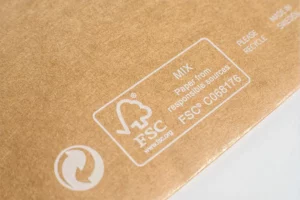You could probably see that in recent years there has been a significant shift towards environmental consciousness in various industries, and the fashion sector is no exception. We often hear in the news that climate change and environmental degradation are growing. Because of this some clothing brands are recognising the need to implement sustainable practices. In this article, we will explore the reasons behind the increasing popularity of eco-friendly packaging for clothing brands and its potential to become the new norm.
Environmental Impact of Traditional Packaging
In today’s world, where environmental consciousness is on the rise, it is crucial to address the significant environmental impact of traditional packaging used in the clothing industry. As a packaging company, we witnessed firsthand how the choices we make in packaging can have far-reaching consequences on the planet. So, let’s explore the negative effects of traditional clothing packaging and its contribution to pollution and waste.
1. Excessive Plastic Waste
Traditional clothing packaging heavily relies on plastic materials, such as polybags and plastic wraps. These materials are lightweight, durable, and cost-effective, making them popular choices for the fashion industry. However, the widespread use of plastic packaging has led to a massive build-up of plastic waste in landfills and oceans. Plastic takes hundreds of years to decompose, causing severe harm to wildlife and marine ecosystems.
2. Carbon Footprint and Greenhouse Gas Emissions
The production and transportation of conventional packaging materials, especially those made from non-renewable resources, contribute to a significant carbon footprint. The extraction, manufacturing, and disposal processes release greenhouse gases into the atmosphere, exacerbating climate change. As eco-conscious consumers demand more sustainable practices, clothing brands must address these emissions to reduce their environmental impact.
3. Land and Water Pollution
The improper disposal of conventional packaging contributes to land and water pollution. Plastic packaging, in particular, breaks down into microplastics that contaminate soil and water sources. These pollutants can find their way into the food chain, posing health risks to humans and wildlife alike. Additionally, chemicals used in packaging production can leach into the environment, further harming ecosystems.
4. Non-Recyclable and Non-Biodegradable Materials
Many conventional packaging materials used in the clothing industry are not easily recyclable or biodegradable. As a result, these materials end up in landfills, where they take up valuable space and contribute to environmental degradation. Adopting eco-friendly packaging solutions is essential to reduce the burden on waste management systems.
As you may have realised by now, traditional packaging is causing considerable damage to our planet. And that is one of the reasons why sustainable packaging is becoming a great alternative. So, we suggest that it’s time to discuss the benefits of why fashion brands more and more are applying eco-packaging practices.
Benefits of Eco-Friendly Packaging for Clothing Brands
Enhancing Brand Image and Reputation
When a fashion brand is implementing sustainable packaging as a part of its strategy, it sends a strong message to consumers that the company is committed to eco-friendliness and environmental responsibility. This creates a positive brand image that can attract new customers and improve the brand’s reputation in the industry.
Meeting Consumer Demands
Modern consumers are becoming increasingly environmentally conscious and prefer brands that share their values. By providing eco-friendly packaging, clothing brands can cater to the demands of eco-conscious customers and gain a competitive edge in the market.
Reducing Carbon Footprint
Traditional packaging methods often involve excessive energy consumption and greenhouse gas emissions. Eco-friendly packaging options, on the other hand, require fewer resources and contribute to a reduced carbon footprint. This reduction in environmental impact is a crucial step towards a sustainable future.
Cost-Effectiveness in the Long Run
In the beginning, it may require higher investments to switch to eco-friendly packaging for your clothing. However, in the long run, it proves to be more cost-effective.
What challenges you may face if you decide to make a switch to sustainable packaging
Sourcing Sustainable Materials
One of the primary challenges for clothing brands is sourcing eco-friendly packaging materials at scale. Collaborating with sustainable suppliers and investing in research and development can help overcome this hurdle. However, you also have the option to partner with a packaging company that will take care of suppliers or manufacturers.
You could probably see that in recent years there has been a significant shift towards environmental consciousness in various industries, and the fashion sector is no exception. We often hear in the news that climate change and environmental degradation are growing. Because of this some clothing brands are recognising the need to implement sustainable practices. In this article, we will explore the reasons behind the increasing popularity of eco-friendly packaging for clothing brands and its potential to become the new norm.
Balancing Aesthetics and Eco-Friendliness
Clothing brands often prioritize aesthetics to create a memorable unboxing experience for customers. Achieving the right balance between visually appealing packaging and eco-friendliness can be challenging but not impossible. There are a lot of examples of brands that did this successfully. For example, Zara, Gucci, Puma, Calvin Klein.
Supply Chain Considerations
Integrating eco-friendly packaging into the supply chain requires careful planning and coordination. Brands need to ensure that the packaging materials and designs align with their overall sustainability objectives.
Conclusion
The fashion industry’s shift towards eco-friendly packaging is a positive step towards sustainability and environmental preservation. By adopting biodegradable materials, minimalist designs, and innovative solutions, clothing brands can contribute to a greener future while gaining a competitive advantage.


